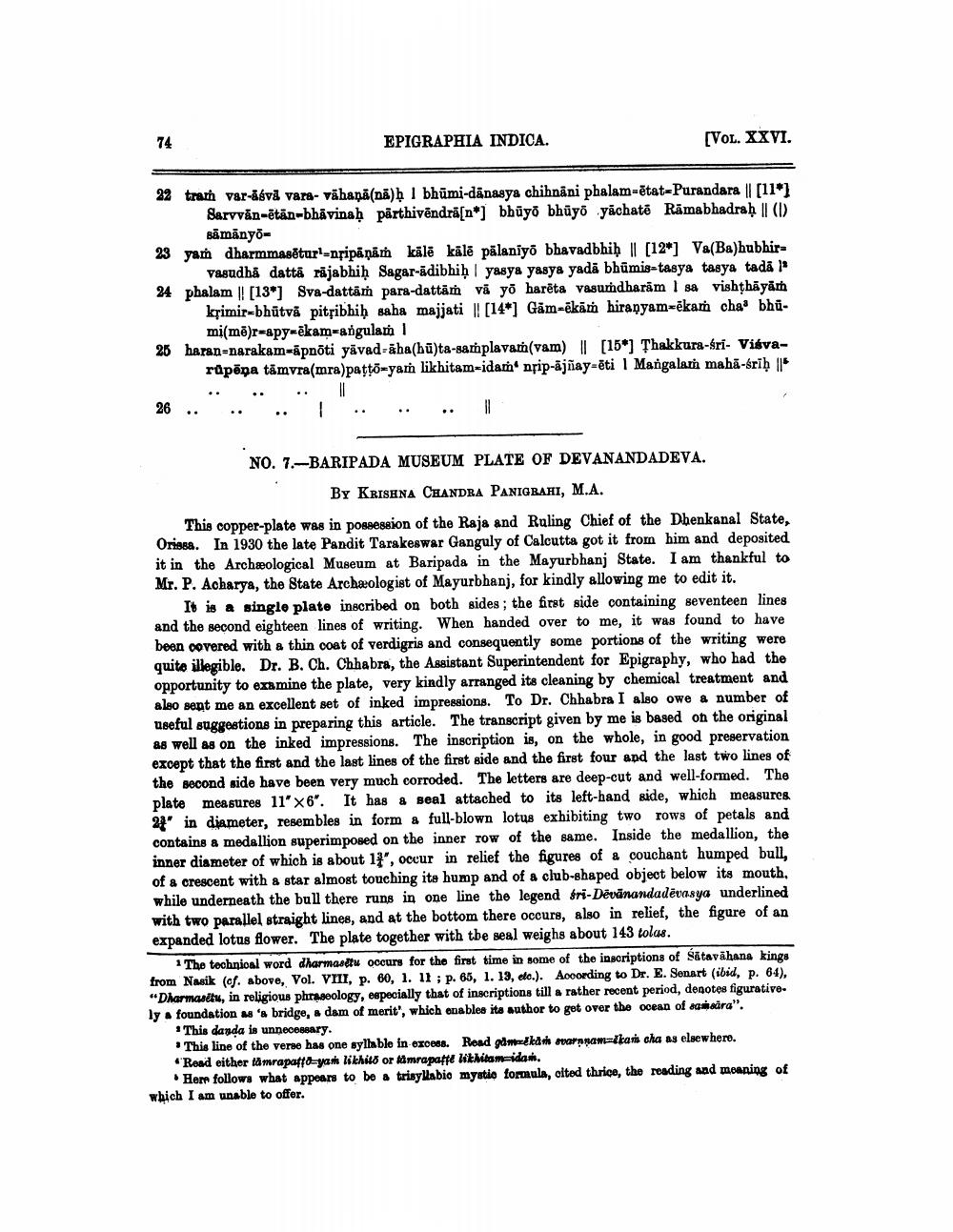________________
EPIGRAPHIA INDICA.
[Vol. XXVI.
22 trarh var-ásvi vara- vähaņā(na)h 1 bhūmi-dānasya chihnāni phalam-ētat-Purandara || [11]
Servvăn-ētän-bhävinaḥ parthivēndrā[n*j bhūyo bhūyo yachatē Rämabhadraḥ || (1)
sāmānyo23 ya dharmmasētur'-nripäņām kālē kālē pälaniyo bhavadbhiḥ || [12*] Va(Ba)hubhir
Vasudhå dattä rajabhih Sagar-ādibhiḥ | yasya yasya yadā bhūmis-tasya tasya tada 24 phalam! [13*] Sva-dattāṁ para-dattām vā yo harēta vasundharam 1 sa vishțhāyām
krimir-bhütvä pitribhiḥ saha majjati || [14*] Gām ēkām hiranyam=ēkam cha bhū
mi(mē)r-apy=ēkam-angula 1 25 haran-narakam=āpnēti yāvad-äha(bū)ta-saṁplavam(vam) || [15*] Thakkura-sri- Visva
rūpēņa tāmvra(mra)patto-yam likhitam-idam.npip-ājñay-ēti 1 Mangalam mahā-srih l"
26
..
..
..
..
..
..
1
NO. 7.-BARIPADA MUSEUM PLATE OF DEVANANDADEVA.
BY KRISHNA CHANDRA PANIGRAHI, M.A.
This copper-plate was in possession of the Raja and Ruling Chief of the Dhenkanal State, Orissa. In 1930 the late Pandit Tarakeswar Ganguly of Calcutta got it from him and deposited it in the Archæological Museum at Baripada in the Mayurbhanj State. I am thankful to Mr. P. Acharya, the State Archæologist of Mayurbhanj, for kindly allowing me to edit it.
It is a single plate inscribed on both sides, the first side containing seventeen lines and the second eighteen lines of writing. When handed over to me, it was found to have been covered with a thin coat of verdigris and consequently some portions of the writing were quite illegible. Dr. B. Ch. Chhabra, the Assistant Superintendent for Epigraphy, who had the opportunity to examine the plate, very kindly arranged its cleaning by chemical treatment and also sent me an excellent set of inked impressions. To Dr. Chhabra I also owe a number of useful suggestions in preparing this article. The transcript given by me is based on the original as well as on the inked impressions. The inscription is, on the whole, in good preservation except that the first and the last lines of the first side and the first four apd the last two lines of the second side have been very much corroded. The letters are deep-cut and well-formed. The plate measures 11" x 6". It has & seal attached to its left-hand side, which measures 27" in diameter, resembles in form & full-blown lotus exhibiting two rows of petals and contains a medallion superimposed on the inner row of the same. Inside the medallion, the inner diameter of which is about 14", occur in relief the figures of a couchant humped bull, of a crescent with a star almost touching its hump and of a club-shaped object below its mouth, while underneath the bull there runs in one line the legend fri-Dévānandadēvasya underlined with two parallel straight lines, and at the bottom there occurs, also in relief, the figure of an expanded lotus flower. The plate together with tbe seal weighs about 143 tolas.
1 The technical word dharmastu occurs for the first time in some of the inscriptions of śātavāhana kings from Nasik (of. above, Vol. VIII, p. 60, 1. 11, p. 65, 1. 13, do.). According to Dr. E. Sonart (ibid, p. 64), "Dharmasitu, in religious phraseology, especially that of inscriptions till a rather recent period, denotes figuratively a foundation as a bridge, a dam of merit', which enables its author to get over the ocean of disara".
* This danda is unnecessary. * This line of the verge has one syllable in excess. Read gamekath marnam-Ikars cha as elsewhere.
Road either tamrapatfo-yam likhits or famrapaffe likhitam-idan.
. Her follows what appears to be a trisyllabio myatio formula, cited thrice, the reading and meaning of which I am unable to offer.




